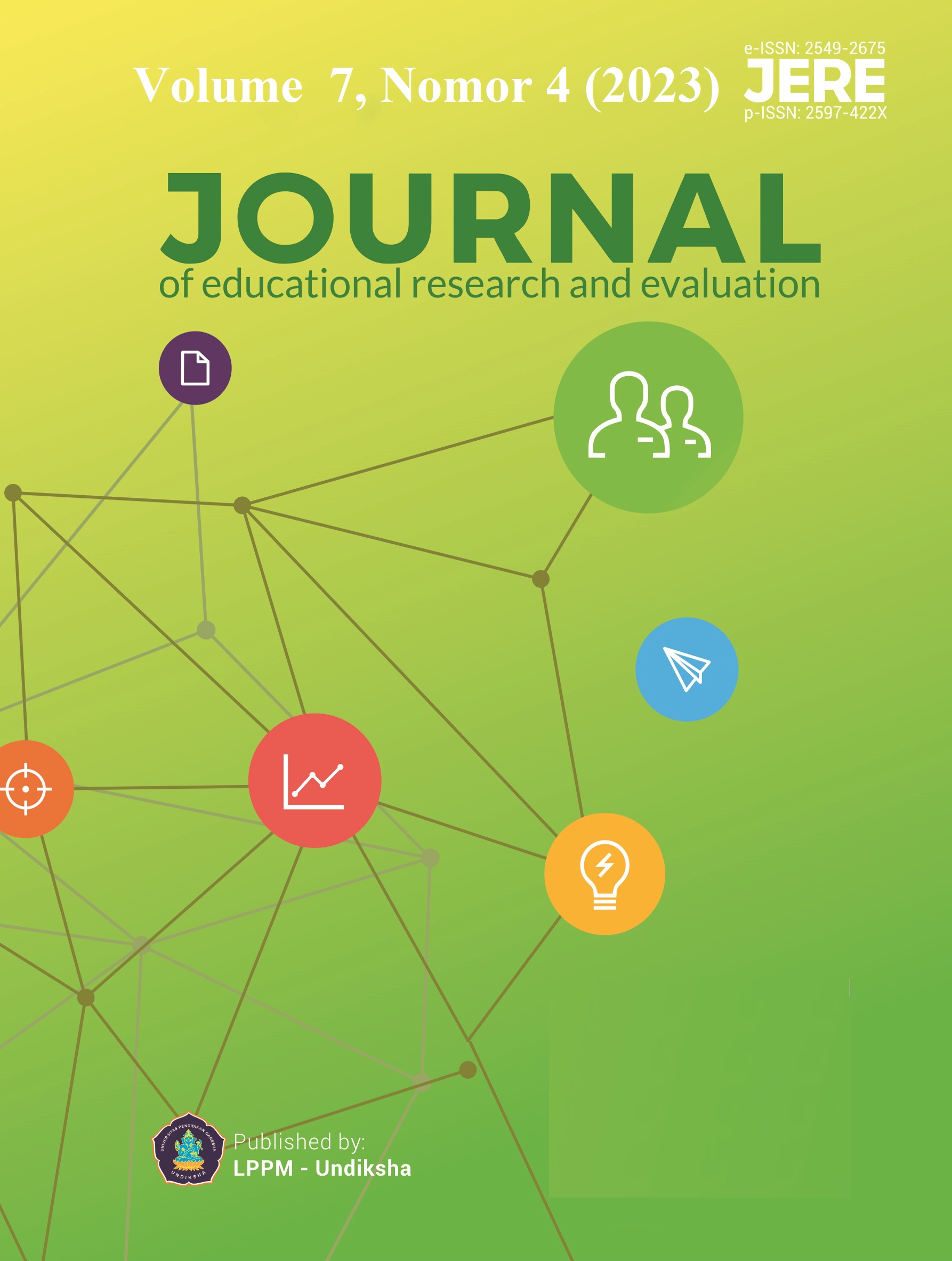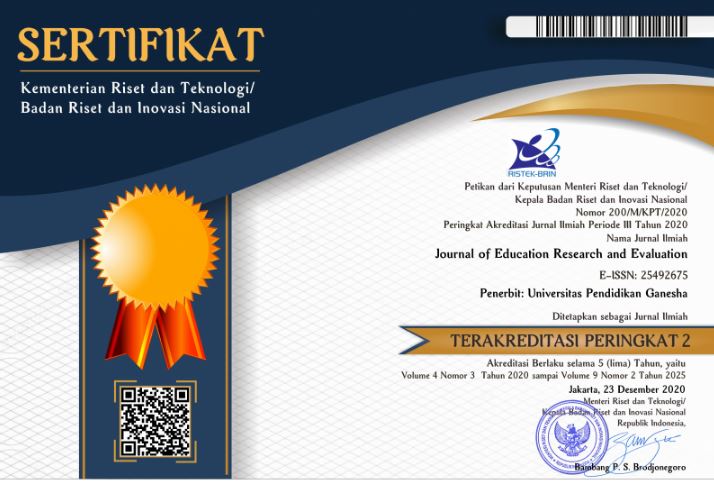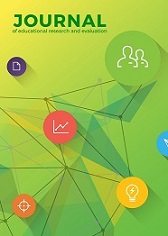Mathematics as Determinant of Students’ HOTS Among HND Electrical and Electronic Engineering Students in Ghana
DOI:
https://doi.org/10.23887/jere.v7i4.62932Keywords:
High Order Thinking skills (HOTS),, Mathematics, Engineering, Technical UniversitiesAbstract
One crucial component of education is developing higher-order thinking skills (HOTS). The aim of this study is to analyze mathematics as determinant of students’ HOTS among HND electrical and electronic engineering student in Ghana. The test format tool used had two indicators, critical and creative thinking, and the subjects for the research were 488 electrical and electronic engineering students from 4 randomly selected Technical Universities in Ghana. The Cronbach Alpha reliability test was performed, and the Pearson test was used to assess the validity of the MAT instrument. Data were processed and analysed using SPSS version 26.0 software. Multiple regression was used as the estimation technique, and the results show a positive high correlation between HOTS and probability (0.757), and positive moderate correlations for algebra (0.669), functions (0.633), trigonometry and complex numbers (0.604), and calculus and differential equations (0.572). These statistics suggest that the level of understanding of mathematics concepts, particularly probability, can determine HOTS. The study's implication is that engineering mathematics curriculum developers should stress the practical applications of mathematics, especially probability in everyday life and offer opportunities for students to use their mathematical knowledge to solve real-world problems in order to develop HOTS.
References
Abutabenjeh, S., & Jaradat, R. (2018). Clarification of research design, research methods, and research methodology: A guide for public administration researchers and practitioners. Teaching Public Administration, 36(3), 237–258. https://doi.org/10.1177/0144739418775787.
Acheampong, K., Dahlan, D., Suryadi, E., & Ramdhany, M. A. (2023). Learning and Assessment of HOTS Among Senior High School Economics Students in Ghana. Jurnal Pendidikan Dan Pengajaran, 56(1). https://doi.org/10.23887/jpp.v56i1.59290.
Akoglu, H. (2018). User’s guide to correlation coefficients. Turkish Journal of Emergency Medicine, 18(3), 91–93. https://doi.org/10.1016/j.tjem.2018.08.001.
Al-Qahtani, M. F. (2015). Associations between approaches to study, the learning environment, and academic achievement. Journal of Taibah University Medical Sciences, 10(1), 56–65. https://doi.org/10.1016/j.jtumed.2015.01.014.
Anderson, L. W., & Krathwohl, D. R. (2021). A taxonomy for learning, teaching, and assessing: A revision of Bloom’s taxonomy of educational objectives. Longman.
Andriani, A., Dewi, I., & Halomoan, B. (2018). Development of mathematics learning strategy module, based on higher order thinking skill (HOTS) to improve mathematic communication and self efficacy on students mathematics department. Journal of Physics: Conference Series, 970(1), 12028. https://doi.org/10.1088/1742-6596/970/1/012028.
Apuke, O. D. (2017). Quantitative research methods: A synopsis approach. Kuwait Chapter of Arabian Journal of Business and Management Review, 33, 1–8. https://doi.org/10.12816/0040336.
Ariati, C., & Juandi, D. (2022). Realistic Mathematic Education on Higher-Order Thinking Skill Mathematics of Students. Kalamatika: Jurnal Pendidikan Matematika, 7(2), 219–236. https://doi.org/10.22236/KALAMATIKA.vol7no2.2022pp219-236.
Boldina, I., & Beninger, P. G. (2016). Strengthening statistical usage in marine ecology: Linear regression. Journal of Experimental Marine Biology and Ecology, 474, 81–91. https://doi.org/10.1016/j.jembe.2015.09.010.
Bonyah, E., & Clark, L. J. (2022). Pre-service Teachers’ Perceptions of and Knowledge for Mathematical Modelling in Ghana. Contemporary Mathematics and Science Education, 3(1), ep22011. https://doi.org/10.30935/conmaths/11932.
Chen, W. E. I., Hribar, P., & Melessa, S. (2018). Incorrect inferences when using residuals as dependent variables. Journal of Accounting Research, 56(3), 751–796. https://doi.org/10.1111/1475-679X.12195.
Cloonan, M. R., Cloonan, D. J., Lynn Schlitzkus, L., & Fingeret, A. L. (2020). Learners with Experience in Surgical Scrub Benefit from Additional Education with an Interactive E-Learning Module. Journal of the American College of Surgeons, 231(4), e196. https://doi.org/10.1016/j.jamcollsurg.2020.08.521.
Costa, S. F., & Diniz, M. M. (2022). Application of logistic regression to predict the failure of students in subjects of a mathematics undergraduate course. Education and Information Technologies, 27(9), 12381–12397. https://doi.org/10.1007/s10639-022-11117-1.
Cresswell, C., & Speelman, C. P. (2020). Does mathematics training lead to better logical thinking and reasoning? A cross-sectional assessment from students to professors. PLoS One, 15(7). https://doi.org/10.1371/journal.pone.0236153.
Deeks, J. J., Higgins, J. P. T., Altman, D. G., & Group, C. S. M. (2019). Analysing data and undertaking meta‐analyses. Cochrane Handbook for Systematic Reviews of Interventions, 241–284.
Durachman, D., & Cahyo, E. D. (2020). Pengaruh Pendekatan Matematika Realistik terhadap Kemampuan Berpikir Kreatif dan Koneksi Matematis Siswa. Tapis: Jurnal Penelitian Ilmiah, 4(1), 56–74. https://doi.org/10.32332/tapis.v4i1.1954.
Farida, F., Hartatiana, H., & Joemsittiprasert, W. (2019). The use of Realistic Mathematics Education (RME) in improving mathematical analogical ability and habits of mind. Al-Jabar: Jurnal Pendidikan Matematika, 10(2), 175–186. https://doi.org/10.24042/ajpm.v10i2.3540.
Ferrer, E., & Staley, K. (2016). Designing an EFL Reading Program to Promote Literacy Skills, Critical Thinking, and Creativity. CATESOL Journal, 28(2), 79–104. https://eric.ed.gov/?id=EJ1119613.
Ghasempour, Z., Kashefi, H., Bakar, M. N., & Miri, S. A. (2012). Higher-Order Thinking via Mathematical Problem Posing Tasks among Engineering Students. ASEAN Journal of Engineering Education, 1(1). https://ajee.utm.my/index.php/ajee/article/view/44.
Hilmi, I., & Dewi, I. (2021). High Order Thinking Skills: Can It Increase by using Realistic Mathematics Education? Journal of Physics: Conference Series, 1819(1), 12056. https://doi.org/10.1088/1742-6596/1819/1/012056.
Jansen, T., & Möller, J. (2022). Teacher judgments in school exams: Influences of students’ lower-order-thinking skills on the assessment of students’ higher-order-thinking skills. Teaching and Teacher Education, 111, 103616. https://doi.org/10.1016/j.tate.2021.103616.
Laurens, T., Batlolona, F. A., Batlolona, J. R., & Leasa, M. (2017). How Does Realistic Mathematics Education (RME) Improve Students’ Mathematics Cognitive Achievement? EURASIA Journal of Mathematics, Science and Technology Education, 14(2), 569–578. https://doi.org/10.12973/ejmste/76959.
Lehtinen, E., Hannula-Sormunen, M., McMullen, J., & Gruber, H. (2017). Cultivating mathematical skills: From drill-and-practice to deliberate practice. ZDM, 49, 625–636.
Liu, J., Ma, Y., Sun, X., Zhu, Z., & Xu, Y. (2021). A Systematic Review of Higher-Order Thinking by Visualizing its Structure Through HistCite and CiteSpace Software. Asia-Pacific Education Researcher. https://doi.org/10.1007/s40299-021-00614-5.
Lu, K., Yang, H. H., Shi, Y., & Wang, X. (2021). Examining the key influencing factors on college students’ higher-order thinking skills in the smart classroom environment. International Journal of Educational Technology in Higher Education. https://doi.org/10.1186/s41239-020-00238-7.
Minarni, A., & Napitupulu, E. E. (2020). The Role of Constructivism-Based Learning in Improving Mathematical High Order Thinking Skills of Indonesian Students. Infinity Journal, 9(1), 111. https://doi.org/10.22460/infinity.v9i1.p111-132.
Muhali, M. (2019). Pembelajaran Inovatif Abad Ke-21. Jurnal Penelitian Dan Pengkajian Ilmu Pendidikan: E-Saintika, 3(2), 25–50. https://doi.org/10.36312/e-saintika.v3i2.126.
Muhayimana, T., Kwizera, L., & Nyirahabimana, M. R. (2022). Using Bloom’s taxonomy to evaluate the cognitive levels of Primary Leaving English Exam questions in Rwandan schools. Curriculum Perspectives, 42(1), 51–63. https://doi.org/10.1007/s41297-021-00156-2.
Nguyễn, T. M. T., & Nguyễn, T. T. L. (2017). Influence of explicit higher-order thinking skills instruction on students’ learning of linguistics. Thinking Skills and Creativity, 26, 113–127. https://doi.org//10.1016/j.tsc.2017.10.004.
Nortvedt, G. A., & Siqveland, A. (2019). Are beginning calculus and engineering students adequately prepared for higher education? An assessment of students’ basic mathematical knowledge. International Journal of Mathematical Education in Science and Technology, 50(3), 325–343. https://doi.org/10.1080/0020739X.2018.1501826.
Oktiningrum, W., & Wardhani, D. A. P. (2020). Developing HOT’s mathematics task with Indonesian heritage as context to assess mathematical literacy of students in primary school. International Journal for Educational and Vocational Studies, 1(8), 69. https://doi.org/10.29103/ijevs.v2i1.1997.
Olsen, A. A., McLaughlin, J. E., & Harpe, S. E. (2020). Using multiple linear regression in pharmacy education scholarship. Currents in Pharmacy Teaching and Learning, 12(10), 1258–1268. https://doi.org/10.1016/j.cptl.2020.05.017.
Prakash, R., & Litoriya, R. (2022). Pedagogical Transformation of Bloom Taxonomy’s LOTs into HOTs: An Investigation in Context with IT Education. Wireless Personal Communications, 122(1), 725–736. https://doi.org/10.1007/s11277-021-08921-2.
Ramírez-Montoya, M.-S. (2017). Handbook of research on driving STEM learning with educational technologies. IGI Global.
Riggs, C. D., Kang, S., & Rennie, O. (2020). Positive impact of multiple-choice question authoring and regular quiz participation on student learning. CBE—Life Sciences Education, 19(2), ar16. https://doi.org/10.1187/cbe.19-09-0189.
Saepuloh, D., Sabur, A., Lestari, S., & Mukhlishoh, S. U. (2021). Improving students’ critical thinking and self-efficacy by learning higher order thinking skills through problem based learning models. JPI (Jurnal Pendidikan Indonesia), 10(3), 495–504. https://doi.org/10.23887/jpi-undiksha.v10i3.31029.
Sarstedt, M., Mooi, E., Sarstedt, M., & Mooi, E. (2019). Regression analysis. A Concise Guide to Market Research: The Process, Data, and Methods Using IBM SPSS Statistics, 209–256.
Sasson, I., Yehuda, I., & Malkinson, N. (2018). Fostering the skills of critical thinking and question-posing in a project-based learning environment. Thinking Skills and Creativity, 29, 203–212. https://doi.org/10.1016/j.tsc.2018.08.001.
Schmidt, A. F., & Finan, C. (2018). Linear regression and the normality assumption. Journal of Clinical Epidemiology, 98, 146–151. https://doi.org/10.1016/j.jclinepi.2017.12.006.
Sharma, V., & Kumar, R. (2017). Dating of ballpoint pen writing inks via spectroscopic and multiple linear regression analysis: A novel approach. Microchemical Journal, 134, 104–113. https://doi.org/10.1016/j.microc.2017.05.014.
Shu Mei, Y., & Yan, Z. (2005). Higher‐Order Thinking in Singapore Mathematics Classrooms. Centre for Research in Pedagogy and Practice: National Institute of Education.
Singh, C. K. S., Gopal, R., Ong, E. T., Singh, T. S. M., Mostafa, N. A., & Singh, R. K. A. (2020). Esl Teachersâ€Tm Strategies To Foster Higher-Order Thinking Skills To Teach Writing. Malaysian Journal of Learning and Instruction, 17(2), 195–226. https://doi.org/10.32890/mjli2020.17.2.7.
Sokolowski, A., Yalvac, B., & Loving, C. (2011). Science modelling in pre-calculus: how to make mathematics problems contextually meaningful. International Journal of Mathematical Education in Science and Technology, 42(3), 283–297. https://doi.org/10.1080/0020739X.2010.526255.
Soysal, Y. (2021). Talking science: Argument-based inquiry, teachers’ talk moves, and students’ critical thinking in the classroom. Science & Education, 30(1), 33–65. https://doi.org/10.1007/s11191-020-00163-1.
Srinivasan, R., Lohith, C. P., Srinivasan, R., & Lohith, C. P. (2017). Main study—detailed statistical analysis by multiple regression. Strategic Marketing and Innovation for Indian MSMEs, 69–92. https://link.springer.com/chapter/10.1007/978-981-10-3590-6_9.
Sun, H., Xie, Y., & Lavonen, J. (2022). Exploring the structure of students’ scientific higher order thinking in science education. Thinking Skills and Creativity, 43, 100999. https://www.sciencedirect.com/science/article/pii/S1871187122000025.
Suparman, S., Juandi, D., & Tamur, M. (2021). Does problem-based learning enhance students’ higher order thinking skills in mathematics learning? A systematic review and meta-analysis. 2021 4th International Conference on Big Data and Education, 44–51. https://doi.org/10.1145/3451400.3451408.
Tanujaya, B., Mumu, J., & Margono, G. (2017). The Relationship between Higher Order Thinking Skills and Academic Performance of Student in Mathematics Instruction. International Education Studies, 10(11), 78. https://doi.org/10.5539/ies.v10n11p78.
Thuneberg, H. M., Salmi, H. S., & Bogner, F. X. (2018). nquiry-based maHow creativity, autonomy and visual reasoning contribute to cognitive learning in a STEAM hands-on ith module. Thinking Skills and Creativity, 29, 153–160. https://doi.org/10.1016/j.tsc.2018.07.003.
Tseng, K.-H., Chang, C.-C., Lou, S.-J., & Chen, W.-P. (2013). Attitudes towards science, technology, engineering and mathematics (STEM) in a project-based learning (PjBL) environment. International Journal of Technology and Design Education, 23, 87–102. https://doi.org/10.1007/s10798-011-9160-x.
Vidergor, H. E. (2018). Effectiveness of the multidimensional curriculum model in developing higher-order thinking skills in elementary and secondary students. The Curriculum Journal, 29(1), 95–115. https://doi.org/10.1080/09585176.2017.1318771.
Yu, H., Jiang, S., & Land, K. C. (2015). Multicollinearity in hierarchical linear models. Social Science Research, 53, 118–136. https://doi.org/10.1016/j.ssresearch.2015.04.008.
Downloads
Published
How to Cite
Issue
Section
License
Copyright (c) 2023 Theodore Oduro-Okyireh, Prof. Dr. Budi Mulyanti, Prof. Dr. Dedi Rohendi, Kennedy Acheampong, Rev. Dr. George Oduro-Okyireh

This work is licensed under a Creative Commons Attribution-ShareAlike 4.0 International License.
Authors who publish with the Journal of Evaluation and Research in Education (JERE) agree to the following terms:
- Authors retain copyright and grant the journal the right of first publication with the work simultaneously licensed under a Creative Commons Attribution License (CC BY-SA 4.0) that allows others to share the work with an acknowledgment of the work's authorship and initial publication in this journal.
- Authors are able to enter into separate, additional contractual arrangements for the non-exclusive distribution of the journal's published version of the work (e.g., post it to an institutional repository or publish it in a book), with an acknowledgment of its initial publication in this journal.
- Authors are permitted and encouraged to post their work online (e.g., in institutional repositories or on their website) prior to and during the submission process, as it can lead to productive exchanges, as well as earlier and greater citation of published work. (See The Effect of Open Access)











